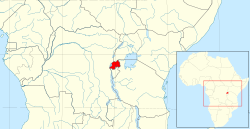
Back Regne de Ruanda Catalan Rwandské království Czech Königreich Ruanda German Reino de Ruanda Spanish Royaume du Rwanda French Masarautar Ruwanda Hausa Kerajaan Rwanda ID Regno del Ruanda Italian ルワンダ王国 Japanese Koninkrijk Rwanda Dutch
Kingdom of Rwanda Ubwami bw'u Rwanda (Kinyarwanda) Koninkrijk Roeanda (Dutch) Royaume du Rwanda (French) Königreich Ruanda (German) | |||||||
|---|---|---|---|---|---|---|---|
| c. 14th century–1961 | |||||||
 | |||||||
| Status | Independent state (15th century–1897) Part of German East Africa (1897–1916) Part of Ruanda-Urundi (1922–1961) | ||||||
| Capital | Nyanza | ||||||
| Common languages |
| ||||||
| Government | Absolute monarchy | ||||||
| Mwami | |||||||
• Unknown | Gihanga (1st Dyn.) (first) | ||||||
• 1959–1961 | Kigeli V (3rd Dyn.) (last) | ||||||
| History | |||||||
• Established | c. 14th century | ||||||
| 1 July 1961 | |||||||
| |||||||
| Today part of | Rwanda | ||||||
| History of Rwanda | ||||||||||||||||||||||||||||
|---|---|---|---|---|---|---|---|---|---|---|---|---|---|---|---|---|---|---|---|---|---|---|---|---|---|---|---|---|
   | ||||||||||||||||||||||||||||
|
||||||||||||||||||||||||||||
The Kingdom of Rwanda was a Bantu kingdom in modern-day Rwanda, which grew to be ruled by a Tutsi monarchy.[1] It was one of the oldest and the most centralized kingdoms in Central and East Africa.[2] It was later annexed under German and Belgian colonial rule while retaining some of its autonomy. The Tutsi monarchy was abolished in 1961 after ethnic violence erupted between the Hutu and the Tutsi during the Rwandan Revolution which started in 1959.[3] After a 1961 referendum, Rwanda became a Hutu-dominated republic and received its independence from Belgium in 1962.[4]
After the revolution, the last ruling monarch, Kigeli V, was exiled and he eventually settled in the United States. A court in exile has been maintained outside Rwanda ever since the abolition of the monarchy. As of 9 January 2017, the current proclaimed King of Rwanda is Yuhi VI.[5]
- ^ "Rwanda - Cultural institutions | Britannica". www.britannica.com.
- ^ "Colonialism of Central Africa | Britannica". www.britannica.com.
- ^ "Rwanda genocide of 1994 | Britannica". www.britannica.com. 9 October 2023.
- ^ Van Schuylenbergh, Patricia (11 January 2016). "Rwanda, Kingdom of". The Encyclopedia of Empire. John Wiley & Sons, Ltd: 1–3. doi:10.1002/9781118455074.wbeoe047. ISBN 9781118455074.
- ^ "Rwanda's new king named – a father of two living on an estate near Manchester". the Guardian. 12 January 2017.
